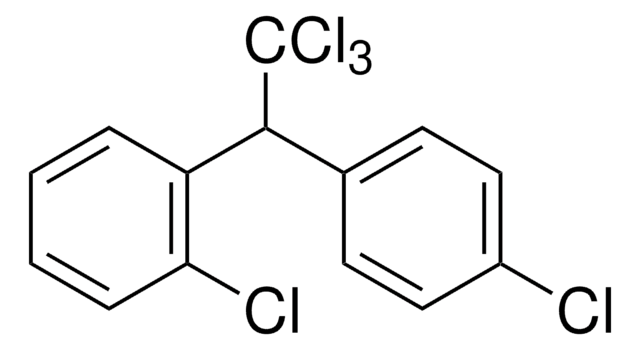48980
4,4′-DDT solution
200 μg/mL in isooctane, PESTANAL®, analytical standard
Synonym(s):
1,1,1-Trichloro-2,2-bis(4-chlorophenyl)ethane solution, 4,4′-DDT solution
About This Item
Recommended Products
grade
analytical standard
product line
PESTANAL®
packaging
ampule of 10 mL
concentration
200 μg/mL in isooctane
technique(s)
HPLC: suitable
gas chromatography (GC): suitable
application(s)
agriculture
environmental
format
single component solution
storage temp.
room temp
SMILES string
Clc1ccc(cc1)C(c2ccc(Cl)cc2)C(Cl)(Cl)Cl
InChI
1S/C14H9Cl5/c15-11-5-1-9(2-6-11)13(14(17,18)19)10-3-7-12(16)8-4-10/h1-8,13H
InChI key
YVGGHNCTFXOJCH-UHFFFAOYSA-N
Gene Information
mouse ... Esr1(13982)
rat ... Ar(24208)
Looking for similar products? Visit Product Comparison Guide
General description
Application
- Air particulate matter by ultrasound assisted extraction micro-scale cell (UAE-MSC) in conjunction with gas chromatography-mass spectrometry operating in negative chemical ionization (GC-MS-NCI).
- Cat hair samples by two dimensional gas chromatography (GC x GC) combined with high resolution time-of-flight mass spectrometry (HR-TOFMS).
- Water samples by thermal desorption (TD)-GC combined with full scan MS as well as liquid injection-GC combined with MS operating in selected ion monitoring (SIM) detection.
- Wildlife liver and serum by QuEChERS (quick, easy, cheap, effective, rugged and safe) extraction and GC coupled to tandem quadrupole mass spectrometry (GC-MS/MS) with MRM detection.
- Marine pore water by solid-phase microextraction (SPME) and TD-GC-MS with SIM detection.
- Surface soil and raw food samples by GC equipped with electron capture detector (ECD).
Legal Information
Related product
signalword
Danger
hcodes
Hazard Classifications
Aquatic Acute 1 - Aquatic Chronic 1 - Asp. Tox. 1 - Flam. Liq. 2 - Skin Irrit. 2 - STOT SE 3
target_organs
Central nervous system
Storage Class
3 - Flammable liquids
wgk_germany
WGK 2
flash_point_f
10.4 °F
flash_point_c
-12 °C
Choose from one of the most recent versions:
Already Own This Product?
Find documentation for the products that you have recently purchased in the Document Library.
Our team of scientists has experience in all areas of research including Life Science, Material Science, Chemical Synthesis, Chromatography, Analytical and many others.
Contact Technical Service











